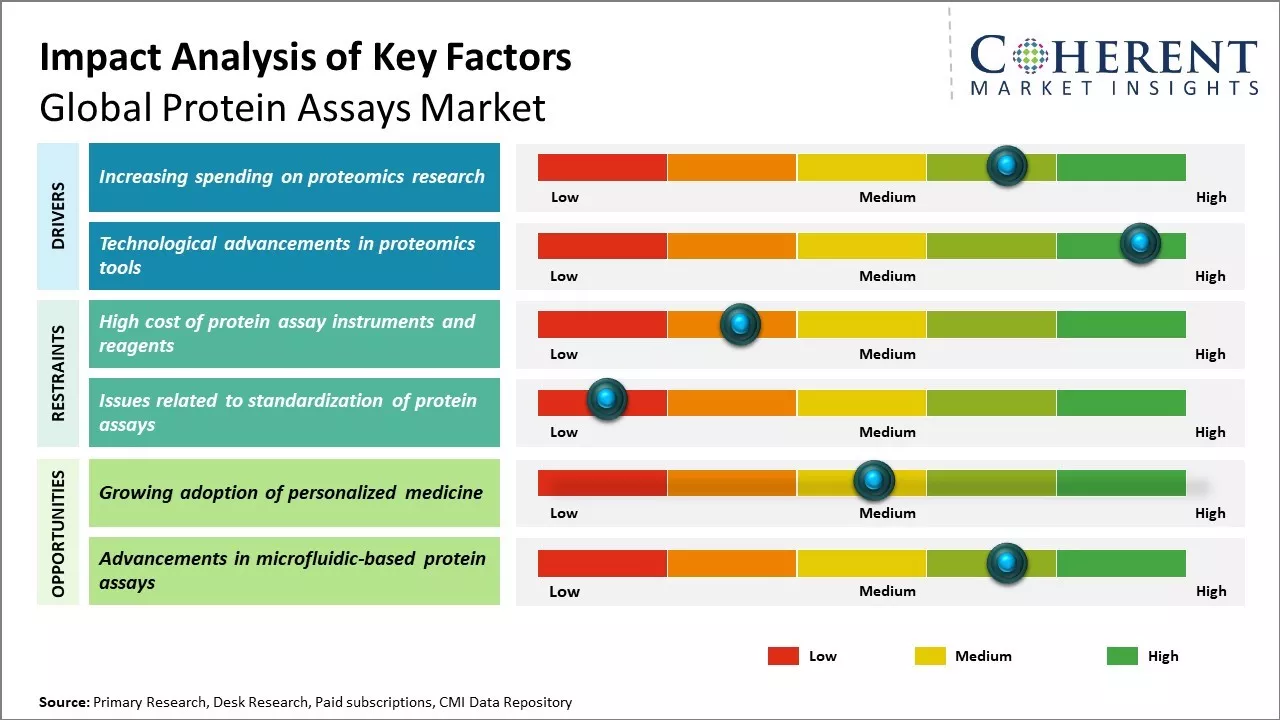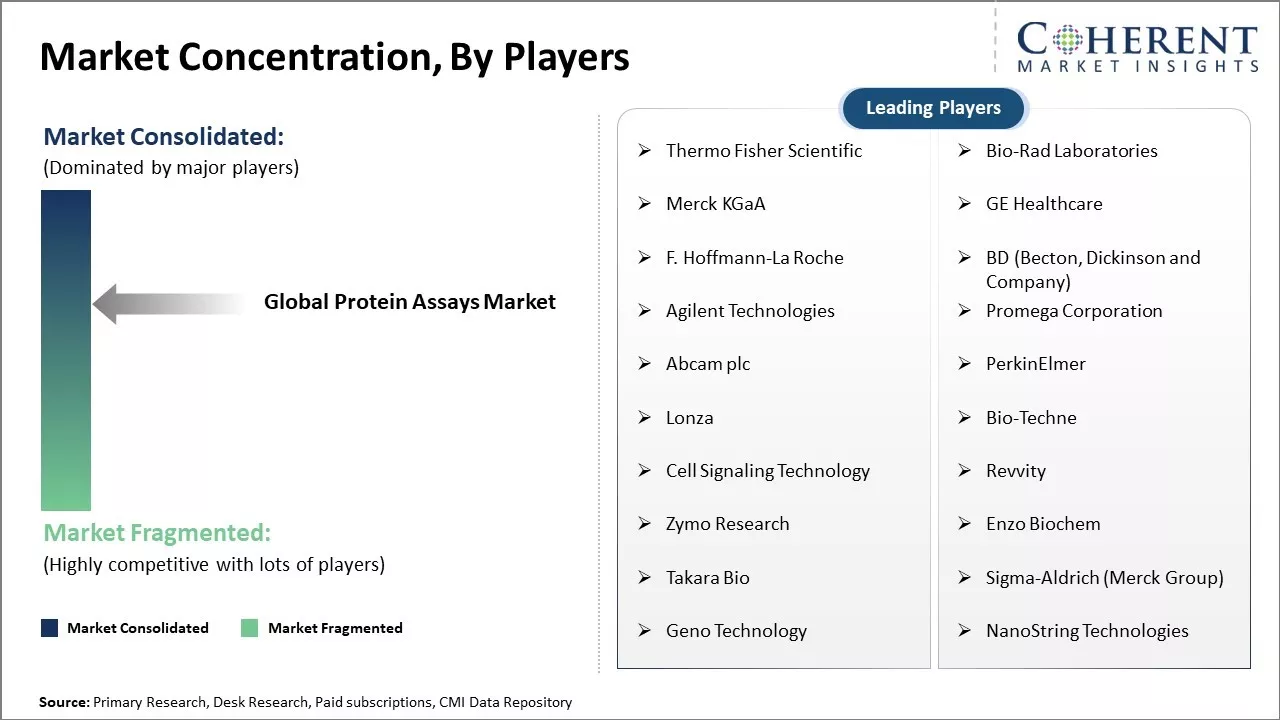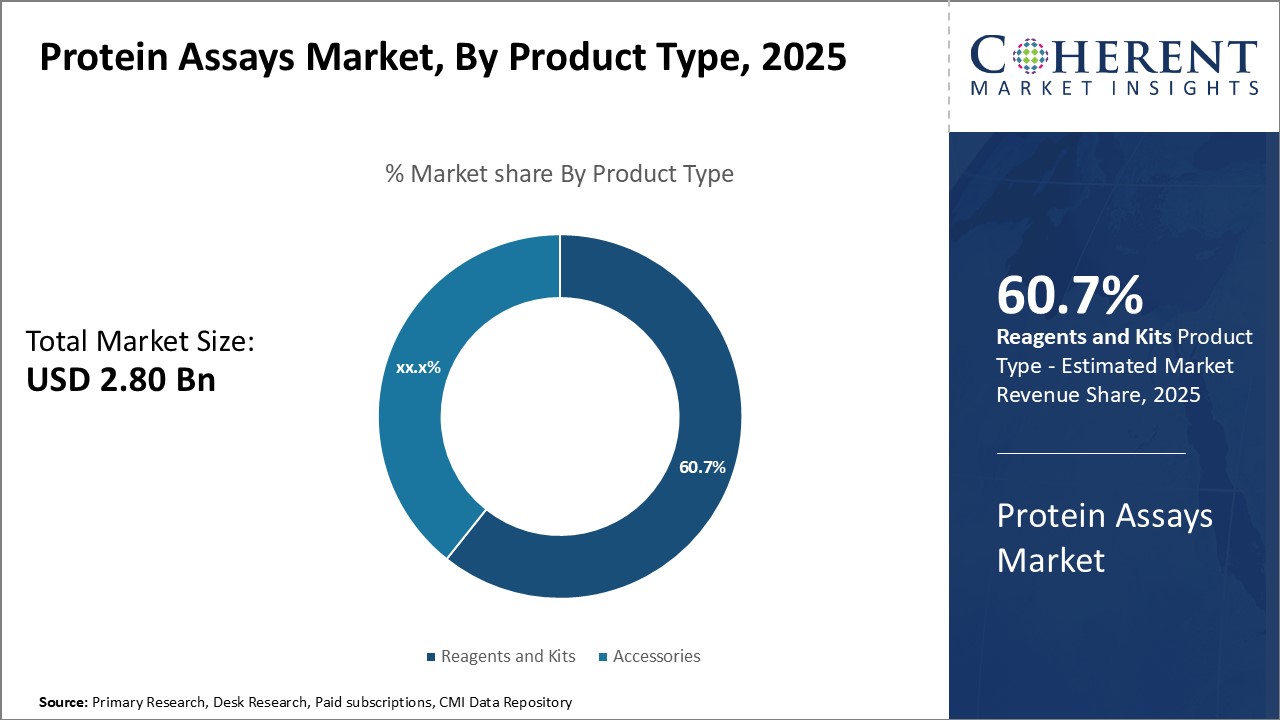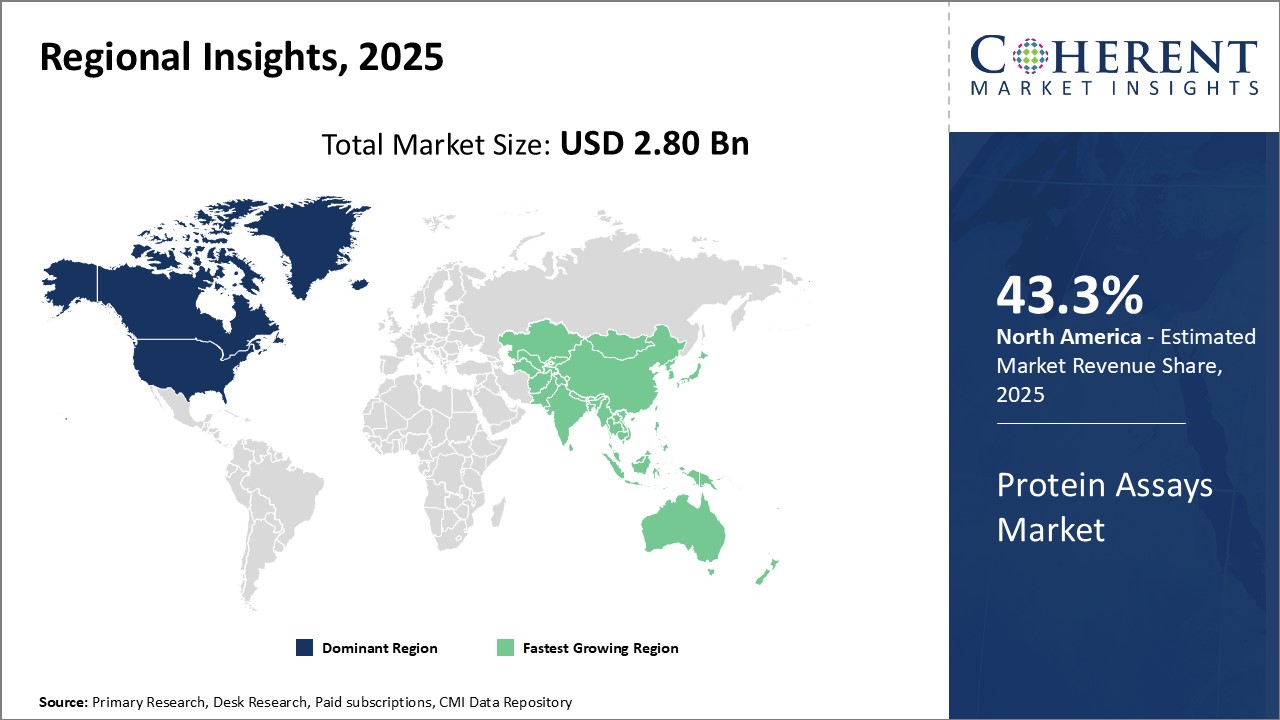Global protein assays market is estimated to be valued at USD 2.80 Bn in 2025 and is expected to reach USD 6.19 Bn by 2032, exhibiting a compound annual growth rate (CAGR) of 12.0% from 2025 to 2032.

Discover market dynamics shaping the industry: Download Free Sample
Growing biopharmaceutical and biotechnology industries can boost demand for protein-based drugs and diagnostics. R&D in disease diagnostics and drug discovery have further boosted the need for protein assay procedures.
Increasing spending on proteomics research
With greater focus on precision medicine, the field of proteomics has witnessed significant advancements. Governments and private institutions across major economies have ramped up their funding for proteomics initiatives and collaborative projects. This positive trend towards greater proteomics spending can boost demand for advanced protein assay tools and kits. Researchers rely on protein assays to analyze and quantify proteins, which helps in developing deeper understanding about various biological systems at the molecular level. More spending on proteomics translate to more assays being performed in academic as well as pharmaceutical laboratories. Establishing comprehensive protein maps of human tissue and biofluids can accelerate diagnosis and treatment of complex diseases. It also helps gain insights into disease pathology and progression. Large scale studies involving thousands of patient samples often require analysis of protein expression levels or post-translational modifications.
This elevates the requirement for high throughput, reproducible and automated protein quantification technologies. Majority of additional proteomics expenditure is directed towards multi-omic initiatives that integrate genomics, transcriptomics and proteomics data. The focus is on applying system biology approaches to better profile cancer at molecular level, understand mechanism of drug resistance and map protein-protein interactions. Disease centered biobanks in Europe and U.S. now host samples and clinical datasets numbering in hundreds of thousands. Analyzing these valuable resources requires assay tools and kits that can analyze thousands of specimens within set timelines and budget. This boosts demand from both governments funded as well as industry sponsored clinical studies and trials.
National level "Moonshot" programs in proteomics have spurred commercial efforts towards development of innovative protein assays. Companies are innovating assays compatible with single-cell analysis, capable of providing deeper insights into tissue heterogeneity at very high resolution. Others are improving compatibility of assays for mass-spectrometry based platforms to enable comprehensive and simultaneous analysis of proteoforms, isoforms and post-translational modifications from limited sample amounts. Success of such initiatives would depend on sustaining adequate funding support both for academic as well as private sector proteomics R&D over the long run.

Get actionable strategies to beat competition: Download Free Sample
Technological advancements in proteomics tools
Remarkable strides in systems biology approaches and omics technologies have transformed the field of proteomics in recent years. More powerful mass-spectrometers, microfluidics-based devices, high resolution microscopy tools and automated assay platforms have enhanced capabilities for comprehensive and in-depth protein analysis. Researchers can now analyze proteomes with greater accuracy, speed, resolution and throughput. Advancements such as single-cell proteomics, spatial proteomics, and quantitative standard-free proteomics are improving knowledge of molecular phenotypes. This widens scope and scale of proteomics studies. Growing sophistication of proteomics tools can offer new opportunities for development of synergistic multi-omics workflows. Integrating functional outputs of genomics and transcriptomics with insights from proteomics is key for building predictive models of cellular systems. Companies recognize the need for protein assays that can analyze thousands of samples not just from tissue lysates but other specimen types. Assays compatible with imaging mass-spectrometry are an example meeting this demand. Tools enabling characterization of protein isoforms and PTMswithin the same workflow boost statistical power of clinical studies. This transforms requirements for assays in terms of performance, scope and automation. Advancements like microfluidic chips, proximity extension assays and bead/array based assays improve precision, throughput and reduce sample volume needs. Newer assays require just picograms of protein for accurate quantification.
Key Takeaways from Analyst:
Global protein assays market growth is driven by rising demand for personalized medicine and increasing focus on protein biomarker discovery and validation. Growing biologics and biopharmaceuticals sector can also boost demand for protein assays in drug development.
Strict regulatory guidelines around protein-based therapeutic development can hamper the market growth. Variations in assay results across different platforms and the need for well-trained professionals to perform assays are also major challenges faced by market players.
North America region currently dominates the global protein assays market, owing to heavy investments in biosimilars and biologics R&D. The Asia Pacific region is expected to witness the highest growth and emerge as the fastest growing market due to increasing healthcare investments and improving biomedical research infrastructure in China and India. Rising incidence of chronic diseases can boost demand for protein-based drug development and diagnostics.
The market is highly competitive with the presence of numerous mid-sized to large players. Industry participants are investing in assay kit innovations and automation to strengthen their product portfolios and market position.
Market Challenges: High cost of protein assay instruments and reagents
Global protein assays market growth can be hampered due to high cost of instruments and reagents required for conducting protein assays. Protein assay instruments such as spectroscopy instruments, HPLC, microfluidics are quite expensive for small to medium scale research facilities and diagnostic labs in developing regions. Moreover, routine maintenance of these precision instruments also increases operating costs. On the reagents side, antibodies, dyes, microbeads and protein standards required on a daily basis have a significant recurring cost. This makes protein analysis an expensive or unviable option for basic research in budget-constrained settings. Pricing pressure to reduce the costs of diagnostic tests in healthcare makes it challenging for vendors to significantly mark up the prices of consumables. Unless affordable alternatives are developed through technological innovation, the high infrastructure and material costs will continue restricting the access to protein assays, thus, hampering the market growth, especially in price-sensitive developing markets.
Market Opportunities: Growing adoption of personalized medicine
Rising focus on personalized medicine and precision therapy can offer opportunities for the global protein assays market growth. With the advancement of genomic research, healthcare providers are gaining deeper understanding of how individual patient's genetic makeup, lifestyle and environment influences the risk, onset and progression of diseases. This is facilitating the development of customized treatment plans tailored to the molecular profile of each patient. Protein assays play a vital role in personalized healthcare as these help identify disease-specific biomarkers, pharmacological targets and monitor treatment responses at the protein level. More personalized diagnostics and therapeutics can boost demand for high-throughput, sensitive and quantitative protein analysis. Multiplex assays allowing simultaneous measurement of biomarker protein panels are becoming increasingly important. This shift towards individualized care powered by proteomics can drive the global protein assays market growth in the near future.

Discover high revenue pocket segments and roadmap to it: Download Free Sample
By Product Type - Accessibility drives reagents and kits segment growth
In terms of product type, reagents and kits segment is expected to contribute the highest market share of 60.7% in 2025, owing to its easy availability and affordability. Reagents and kits provide researchers with all the necessary components required for protein quantification and analysis in a single packaged unit. This eliminates the need to purchase individual laboratory reagents and components separately, saving time and costs for end users. The wider product portfolio and variety of pack sizes offered by leading manufacturers allow researchers to choose configurations suitable for their specific applications and throughput needs. Moreover, reagents and kits can be stored long-term due to their formulation and packaging, offering users superior sample-to-sample consistency over multiple assays. The easy-to-use format simplifies workflow for researchers without extensive laboratory experience. The accessibility and convenience factors associated with reagents and kits have made it the preferred product choice, contributing significantly to its leading market share.
By Technology Type- Standardization drives absorbance based protein assays segment growth
In terms of technology type, absorbance based protein assays segment is expected to contribute the highest market share of 42.5% in 2025, owing to its high degree of standardization. Absorbance-based techniques are well-established protein quantification methods that have been standardized over decades of research and development. Assays such as the Bradford and Bicinchoninic acid (BCA) assays have established protocols and procedures that deliver highly reproducible and consistent results. This allows for reliable comparison of protein concentration measurements across different laboratories and equipment. The standard operating procedures readily available in technical documents and online resources simplify protocol optimization and minimize variability factors for end users. Widespread adoption of absorbance-based protein assays in research has also grown their popularity by establishing them as reference standard techniques for method development and validation of other emerging protein quantification methods. The maturity, standardization, and reproducibility offered have made absorbance-based protein assays the most favored technique amongst researchers and supported its position.
By End User- Higher research intensity drives pharmaceutical and biotechnology industry segment growth
In terms of end user, pharmaceutical and biotechnology industry clinical laboratories segment is expected to contribute the highest market share of 56.5% in 2025, owing to its higher research intensity and specialized application demands. Protein quantification and analysis play a vital role in drug discovery, development, and quality control processes undertaken by pharmaceutical and biotech companies. The need for reliable, high-throughput and automated protein assays able to handle the complex sample matrices derived from biological sources makes protein analysis an integral part of research workflows in these industries. Pharmaceutical manufacturing undergoes stringent quality control protocols mandated by regulatory bodies that require demonstrated accuracy and precision of analytical test methods. This drives the need for high quality certified protein quantification kits, reagents and instruments within this industry. Furthermore, large research and development budgets of major pharma/biotech firms enable higher investments in specialized protein analysis solutions compared to other end users. Overall, t research-centric focus and regulatory compliance needs of the pharmaceutical and biotechnology industry contribute significantly to its leadership position as the biggest end user segment for protein assays.

Need a Different Region or Segment? Download Free Sample
North America has established itself as the dominant region in the global protein assays market with an estimated share of 43.3% in 2025. Presence of biotechnology and pharmaceutical industries in the U.S. and growing focus on protein-based drug development has boosted demand for protein quantification and analysis tools in the region. Several leading life sciences companies have their headquarters and core R&D facilities based in the region, driving extensive consumption of protein detection kits and reagents. Furthermore, the region enjoys the presence of many globally recognized research laboratories and academic institutes that require protein assays for various research applications.
Asia Pacific has emerged as the fastest growing regional market for protein assays. Rapid economic development, rising healthcare spending, and growing investments in biomedical sciences across major countries like China and India boosts demand. The region is witnessing expansion of its biomanufacturing infrastructure to cater to the outsourcing needs of large pharmaceutical companies. This has prompted local manufacturers to increase their focus on developing cost-effective, high-quality protein assay products. These also strive to meet the unique requirements of the domestic industries through customized offerings. Exporting protein assays to other developing Asian and African markets strengthens the regional presence of Asia Pacific manufacturers.
Protein Assays Market Report Coverage
| Report Coverage | Details | ||
|---|---|---|---|
| Base Year: | 2024 | Market Size in 2025: | USD 2.80 Bn |
| Historical Data for: | 2020 To 2024 | Forecast Period: | 2025 To 2032 |
| Forecast Period 2025 to 2032 CAGR: | 12.0% | 2032 Value Projection: | USD 6.19 Bn |
| Geographies covered: |
|
||
| Segments covered: |
|
||
| Companies covered: |
Thermo Fisher Scientific, Bio-Rad Laboratories, Merck KGaA, GE Healthcare, F. Hoffmann-La Roche, BD (Becton, Dickinson and Company), Agilent Technologies, Promega Corporation, Abcamplc, PerkinElmer, Lonza, Bio-Techne, Cell Signaling Technology, Revvity, Zymo Research, Enzo Biochem, Takara Bio, Sigma-Aldrich (Merck Group), Geno Technology, and NanoString Technologies |
||
| Growth Drivers: |
|
||
| Restraints & Challenges: |
|
||
Uncover macros and micros vetted on 75+ parameters: Get instant access to report
*Definition: Global Protein Assays Market includes tests and kits designed to detect and measure protein concentrations in biological samples. These assays are widely used in research, clinical diagnostics, and drug development, aiding in the analysis of protein expression levels, monitoring protein purification, and evaluating protein stability and activity. The market offers a range of products such as reagent kits, microplate readers, protocol guidelines, and standard proteins, which are essential for precise and consistent protein analysis. With ongoing advancements in biomedical research and clinical diagnostics, the demand for protein assays is anticipated to grow significantly.
Share
Share
About Author
Komal Dighe is a Management Consultant with over 8 years of experience in market research and consulting. She excels in managing and delivering high-quality insights and solutions in Health-tech Consulting reports. Her expertise encompasses conducting both primary and secondary research, effectively addressing client requirements, and excelling in market estimation and forecast. Her comprehensive approach ensures that clients receive thorough and accurate analyses, enabling them to make informed decisions and capitalize on market opportunities.
Missing comfort of reading report in your local language? Find your preferred language :
Transform your Strategy with Exclusive Trending Reports :
Frequently Asked Questions
Joining thousands of companies around the world committed to making the Excellent Business Solutions.
View All Our Clients